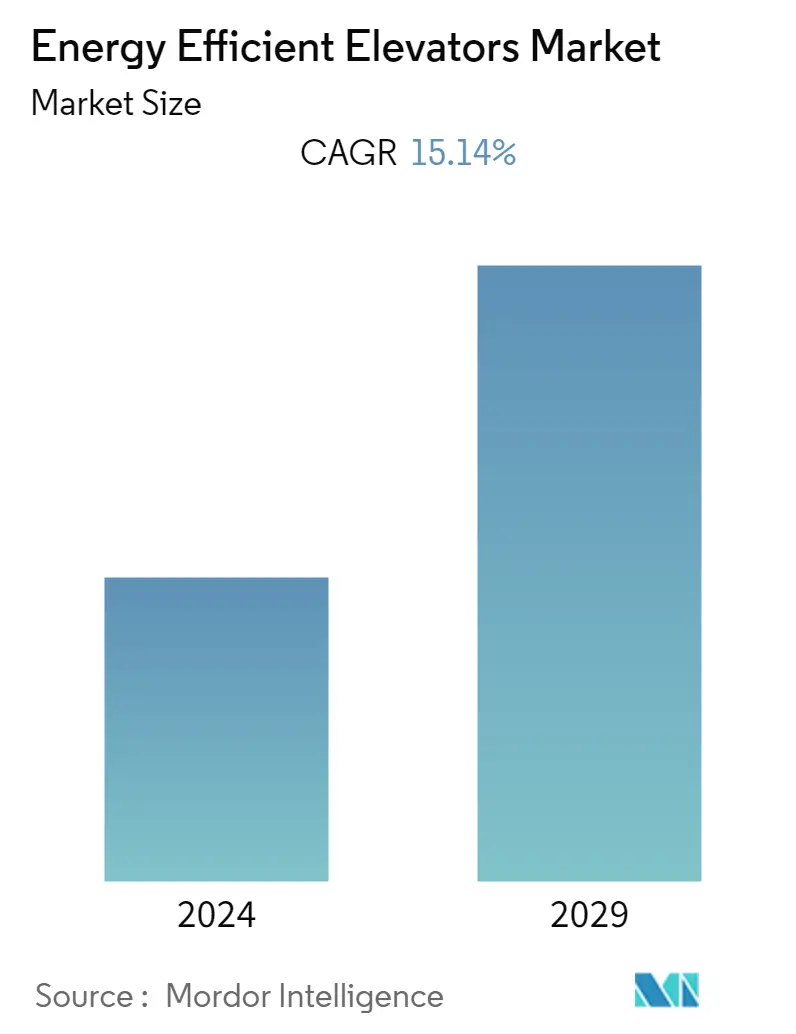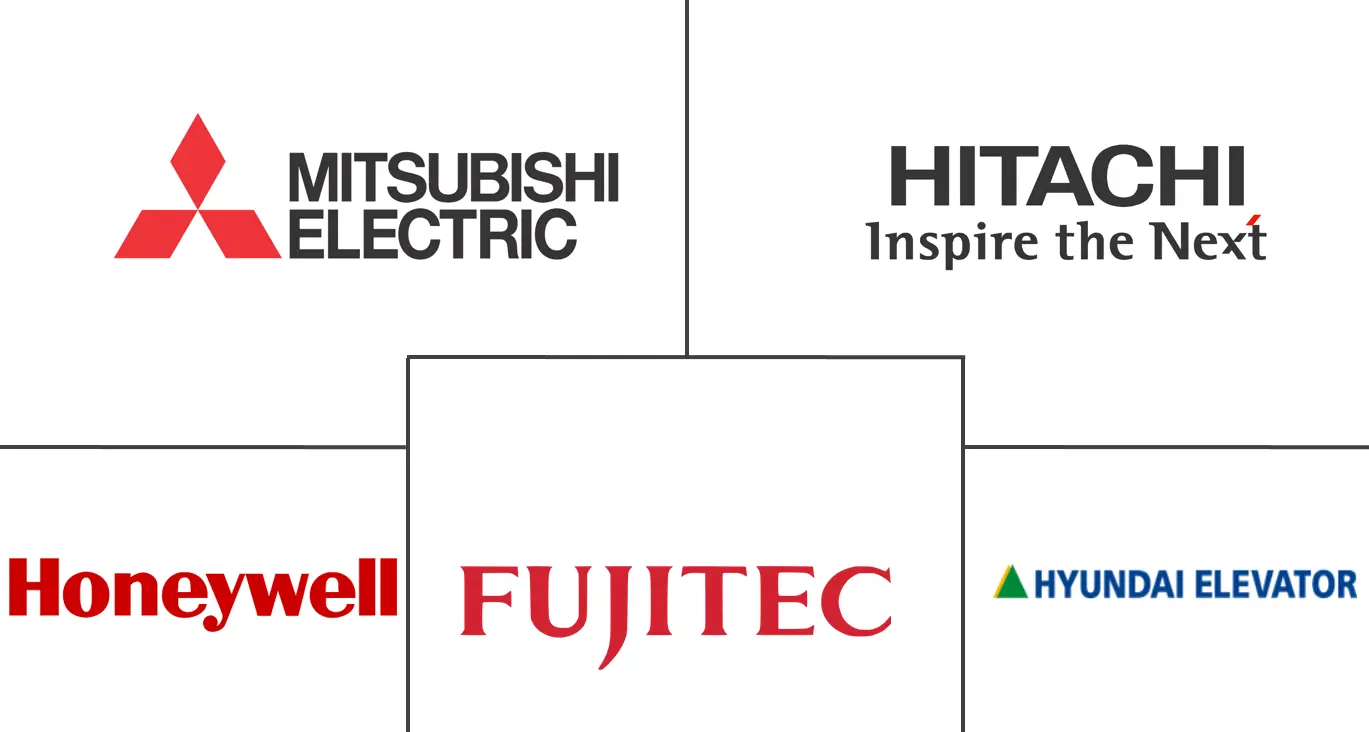Market Size of Energy Efficient Elevators Industry

| Study Period | 2019 - 2029 |
| Base Year For Estimation | 2023 |
| CAGR | 15.14 % |
| Fastest Growing Market | Europe |
| Largest Market | North America |
| Market Concentration | Low |
Major Players
*Disclaimer: Major Players sorted in no particular order |
Energy Efficient Elevators Market Analysis
The energy-efficient elevators market is expected to record a CAGR of about 15.14% over the forecast period (2021 - 2026). With the help of cross-industry innovation, elevator suppliers are developing cable-free elevators that can move both vertically and horizontally. These elevators are typically made of carbon-fiber-reinforced plastic and are powered by linear motors that can move cabs up and down, forward and backward, and left or right on magnetic rails. Cable-free elevators are energy efficient and reduce carbon footprint impacts dramatically. In addition, the integration of connectivity technology and internet features into lifts is a key ongoing trend that offers enhanced security, energy efficiency, and alerts related to repair schedules.
- Due to the increasing demand for energy-efficient systems, the energy-efficient elevators market is expected to witness considerable growth in the coming years, owing to the growing need for commercial energy management systems and residential energy management systems. ThyssenKrupp Elevator Company installed 73 elevators in the World Trade Center, New York, along with the energy management software and controls to monitor and reduce energy consumption.
- Due to mounting electricity prices, especially in high-traffic applications, various advanced technologies (such as destination dispatching and access control systems) are being used to reduce energy consumption.
- Owing to the increasing incidences of COVID-19, the Government across the globe are focusing on building quarantine centers, and hospitals to stop the spreading of the virus. These newly developed buildings will create opportunities for the manufacturers to supply the energy-efficient elevators for hassle-free patient management.
- The COVID-19 has impacted the elevator manufacturing in a greater way. For instance, Thyssenkrupp, which is a significant player in the market, has suspended production at its German elevator factory after two employees tested positive for the rapidly spreading coronavirus. Another elevator manufacturer, Kone, said that the coronavirus is expected to have a major impact on the company's Q1 sales and other operating results. However, the company has stated that its maintenance & installation services in Italy will continue with some exceptions.
- The major restraints of the energy efficient elevators market are the lack of information and awareness of the actual electricity consumption of elevator systems, the lack of information and awareness of the energy-efficient technologies in the market, and the low state of knowledge on the economic efficiency of the technological measures.
Energy Efficient Elevators Industry Segmentation
The energy efficient elevators industry is influenced by the increased demand in the emerging markets and widening applications. A traction elevator travels up and down on a steel rope and has a counterweight on the other end. These are more energy-efficient than hydraulic hoists. By replacing the outdated hardware and investing in some of the sophisticated software, the building owners can make immediate and substantial energy savings.
| Control Systems | |||||
| Elevator Control System | |||||
|
| Automation Systems | |
| Motors and Drivers | |
| Sensors and Controllers | |
| Building Management Systems |
| End User | |
| Industrial | |
| Commercial | |
| Residential | |
| Other End Users |
| Geography | |||||||
| |||||||
| |||||||
| |||||||
| |||||||
|
Energy Efficient Elevators Market Size Summary
The energy-efficient elevators market is poised for significant growth, driven by the increasing demand for sustainable and energy-saving solutions across various sectors. The market is characterized by the development of innovative technologies, such as cable-free elevators made from carbon-fiber-reinforced plastic and powered by linear motors, which offer enhanced energy efficiency and reduced carbon footprints. The integration of connectivity and internet features into elevators is also a prominent trend, providing improved security and energy management. The industrial sector, a major consumer of energy, is witnessing a rise in demand for energy-efficient elevators due to escalating electricity costs and the need for sustainable practices. This demand is further fueled by the growing focus on commercial and residential energy management systems.
In Europe, the market is bolstered by the modernization of buildings and increased construction activities, with manufacturers like Mitsubishi focusing on new product developments to enhance market penetration. The fragmented nature of the market sees key players such as Hitachi, Mitsubishi Electric, and Hyundai Elevators integrating advanced technologies like IoT to align with smart city developments. Recent developments include contracts for large-scale office buildings and the introduction of models that do not require machine rooms, catering to midrise and low-rise structures. Despite challenges like lack of awareness and information on energy-efficient technologies, the market continues to expand, supported by national energy agencies and the ongoing shift towards sustainable building practices.
Energy Efficient Elevators Market Size - Table of Contents
-
1. MARKET DYNAMICS
-
1.1 Market Overview
-
1.2 Market Drivers
-
1.2.1 Increasing Demand for Energy Efficient Systems
-
1.2.2 Due to Mounting Electricity Prices in High-traffic Applications
-
-
1.3 Market Restraints
-
1.3.1 Lack of Information and Awareness in Electricity Consumption Rate and Lack of Technological Efficiency
-
-
1.4 Market Opportunities
-
1.5 Industry Value Chain Analysis
-
1.6 Porter's Five Force Analysis
-
1.6.1 Threat of New Entrants
-
1.6.2 Bargaining Power of Buyers/Consumers
-
1.6.3 Bargaining Power of Suppliers
-
1.6.4 Threat of Substitute Products
-
1.6.5 Intensity of Competitive Rivalry
-
-
1.7 Impact of COVID-19 on the Energy Efficient Elevators Market
-
-
2. MARKET SEGMENTATION
-
2.1 Control Systems
-
2.1.1 Elevator Control System
-
2.1.2 Access Control System
-
2.1.2.1 Card-based Access Control Systems
-
2.1.2.2 Biometric Access Control Solutions
-
2.1.2.3 Keypad-based Access Control Systems
-
-
-
2.2 Automation Systems
-
2.2.1 Motors and Drivers
-
2.2.2 Sensors and Controllers
-
2.2.3 Building Management Systems
-
-
2.3 End User
-
2.3.1 Industrial
-
2.3.2 Commercial
-
2.3.3 Residential
-
2.3.4 Other End Users
-
-
2.4 Geography
-
2.4.1 North America
-
2.4.1.1 United States
-
2.4.1.2 Canada
-
-
2.4.2 Europe
-
2.4.2.1 Germany
-
2.4.2.2 United Kingdom
-
2.4.2.3 France
-
2.4.2.4 Russia
-
2.4.2.5 Rest of Europe
-
-
2.4.3 Asia Pacific
-
2.4.3.1 China
-
2.4.3.2 Japan
-
2.4.3.3 India
-
2.4.3.4 Rest of Asia Pacific
-
-
2.4.4 Latin America
-
2.4.4.1 Brazil
-
2.4.4.2 Mexico
-
2.4.4.3 Argentina
-
2.4.4.4 Rest of Latin America
-
-
2.4.5 Middle East and Africa
-
2.4.5.1 Saudi Arabia
-
2.4.5.2 United Arab Emirates
-
2.4.5.3 South Africa
-
2.4.5.4 Rest of Middle East and Africa
-
-
-
Energy Efficient Elevators Market Size FAQs
What is the current Energy Efficient Elevators Market size?
The Energy Efficient Elevators Market is projected to register a CAGR of 15.14% during the forecast period (2024-2029)
Who are the key players in Energy Efficient Elevators Market?
Hitachi, Ltd., Mitsubishi Electric Corporation, Hyundai Elevators Co., Ltd, Fujitec Co., Ltd and Honeywell International, Inc. are the major companies operating in the Energy Efficient Elevators Market.

